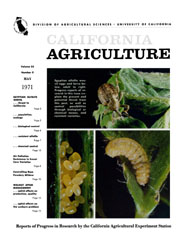All Issues

Cover:
Egyptian alfalfa weevil eggs and larva below, adult to right. Progress reports of research in this issue explain the present and potential threat from this pest, as well as control possibilities through biological or chemical means, and resistant varieties.
May 1971
Volume 25, Number 5
Volume 25, Number 5





